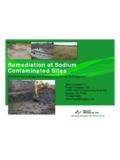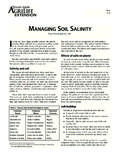Transcription of Nitrogen Fertilizer Recommendations for Corn in Iowa
1 This pamphlet replaces all earlier guidelinesfor using the late-spring test for soil nitrateand all previous Nitrogen Fertilizer recom-mendations based on corn yield goals andcredits for N supplied by legumes and ani-mal manures. Recommendations concern-ing applications of animal manures areprovided in Pm-1596a, Managing manurenutrients for crop fertilization is essential for profit-able corn production. It also is a majorcost of production and can contribute todegradation of the environment. The economic andenvironmental costs of N fertilization are moreimportant than in the past, and they are likely tobecome even more important in the future.
2 Thesecosts provide compelling reasons for intensifyingefforts to improve N management late-spring test for soil nitrate is a new tech-nology that enables site-specific assessments ofplant-available N just before the crop begins rapiduptake of N. Use of this test should help cornproducers manage N to increase their profits whilereducing environmental degradation. All produc-ers are encouraged to use this test, but the way thetest is used depends on whether or not the pro-ducer exercises the option for in-season fertiliza-tion ( , N applications after corn plants are 6inches tall).
3 Producers who apply all their N before emergenceof the crop ( , before planting, at planting, soonafter planting) should apply N at rates indicated inTable 1 and use the late-spring test to evaluate theirN management. Select rates within the rangesgiven by considering price for Fertilizer , expectedprice for grain, supply of subsoil moisture, andfeedback given by the end-of-season cornstalk testin previous years. If price and yield outlook arefavorable, select the upper part of the range; ifunfavorable, select the lower part of the 1. Rates of N usually needed if all N is appliedpreplant or before crop emergence (option for in-season application of N not exercised).
4 Crop categoryN rate (lb. N/acre)Corn on recently manured soils0-90 Corn after established alfalfa0-302nd-year corn after alfalfa0-60 Other corn after corn150-200 Corn after soybean (no manure)100-150 Additional information is provided on page who use the option for in-seasonfertilization ( , split applications or all appliedafter corn plants are 6 inches tall) should apply Nat rates indicated in Table 2 and then use the late-spring test to estimate additional amounts of Nneeded. Rates within the range given should beselected based on the extent to which the producerwants to rely on in-season fertilization, amounts ofrainfall during the previous six months, andfeedback given by the end-of-season cornstalk testin previous of some N before crop emergence isdesirable to avoid the possibility of early-seasondeficiencies and to reduce risks associated withweather conditions that prevent in-season fertiliza-tion.
5 Application of all N before planting, however,reduces the ability to adjust N rates for the effectsof spring weather on amounts of N supplied by thesoil or the amounts lost during spring rainfall. Useof the late-spring test over a period of years pro-vides information that can be used to optimize pre-emergence applications of 2. Rates of N to apply before crop emergenceif the option for in-season fertilization is rate (lb. N/acre)Corn on recently manured soils0-30 Corn after established alfalfa0-302nd-year corn after alfalfa0-30 Other corn after corn50-125 Corn after soybean (no manure) 0-75 The 30-lb.
6 Rates could be applied as a FertilizerRecommendations forCorn in IowaPm-1714 | May 1997L E O P O L D C E N T E RTime of soil SamplingSoil samples should be collected when corn plantsare 6 to 12 inches tall (measured from the groundsurface to the center of the whorl).Selecting Test AreasSoil samples should be collected within several testareas that are 1 to 10 acres and seemingly uniformwith respect to soil characteristics and managementhistories. Care should be taken to avoid unusualspots ( , sites of old barnyards, feedlots, ormanure piles, field edges or ends where fertilizerapplicators may have made skips or double applica-tions, abnormal patches of growing weeds or plantresidues, or small areas where corn plants suggestdifferences in N availability).
7 The optimal number of test areas per farm shouldbe expected to vary with many factors. First-yearusers of the test should consider testing about fiveareas for the first 100 acres and two more areas foreach additional 100 acres. Information gathered inthe first year can be used to help select futuresampling strategies that are appropriate for aparticular of soil SamplingSamples collected for the late-spring soil test mustbe representative of the surface foot of of Cores per SampleSoil samples analyzed for this test should bederived from at least 16 to 24 cores. Care shouldbe taken to ensure that the soil samples are col-lected in a manner that is not biased by the pres-ence of corn rows or bands of Fertilizer .
8 At least 24cores should be collected if anhydrous ammoniawas applied for the present bias can be minimized by collecting soilsamples in sets of eight cores that have variousassigned positions relative to corn rows. By thismethod, the person doing the sampling moves in arandom pattern within the test area to selectapproximate positions for collecting cores. Eachtime a core is collected, however, its exact positionis selected relative to the two nearest corn first core is collected in a row. The second iscollected one-eighth of the distance between anytwo rows after moving to another part of the testarea.
9 The third is collected one-quarter of thedistance between any two corn rows after movingto another part of the test area. The process iscontinued until the eighth core is collected seven-eighths of the distance between any two corn soil from all cores should be crushed andthoroughly mixed before a subsample is removedfor and Shipping soil SamplesMoist soil samples should be protected fromtemperatures above 75 F and should be refriger-ated if they cannot be analyzed within two usually poses no problem if the samplesare without refrigeration for no more than twodays. Assume that soil testing laboratories willprotect the samples as soon as they are samples expected to be without refrigerationfor more than two days should be dried as soon aspossible.
10 Samples can be air-dried by spreading ina thin layer on paper a fan will acceleratedrying. Samples can be dried in an oven providedthe temperature does not exceed 250 that are extremely wet or muddy should notbe sampled. Incorrect results will be obtained ifwater drips from the AnalysisThe late-spring test is based on concentrations ofnitrate- Nitrogen (NO-3-N) in the soil sample. Mostsoil testing laboratories can perform this concentrations also can be measured on thefarm by using commercially available pamphlet expresses nitrate concentrations interms of ppm nitrate-N (parts of N per million partsof dry soil ), which is the same as ppm N as expressed as ppm nitrate must bemultiplied by to be converted to ppm of the soil test should be alert to the possibilityof incorrect results on individual samples.











